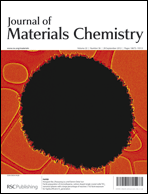First principles investigation of electronic structure change and energy transfer by redox in inverse spinel cathodes LiNiVO4 and LiCoVO4
Abstract
A first-principles investigation on changes of the crystal structure and electronic structure by lithium intercalation was performed for LiNiVO4 and LiCoVO4 with inverse spinel structures. The spin states were found to change from low spin states in the de-lithiated phases to high spin states in the lithiated phases, correlated with the decrease in the octahedral crystal field splitting caused by lithium intercalation. Atomic basin population analysis combined with differential charge density analysis showed that the charge transfer caused by lithium intercalation reduces both the transition metal ions and the oxygen ions, simultaneously weakening the covalent-bonding between them. To obtain a deeper insight into the energy transfer process, the lithiation process was analyzed by considering contributions from the electronic part and ionic part, defined as electron affinity and lithium ion affinity, which costs and releases energy in the lithiation process, respectively. The electron affinity of the host was found to be characteristic of the redox potential while the lithium ion affinity is almost the same for these two cathodes. The 3d electron configuration of the transition metal ions is the dominant factor determining the redox potential although the transition metal ions and the oxygen ions are both reduced. For the host material with d5, d6, and d7 configurations, our results reveal a Λ-shape for the electron affinity, with the maximum at the d6 configuration, and correspondingly a V-shape for the reduction potential, with the minimum at the d6 configuration.


 Please wait while we load your content...
Please wait while we load your content...